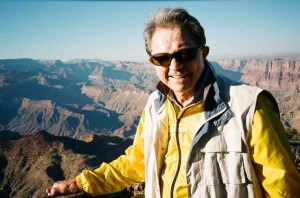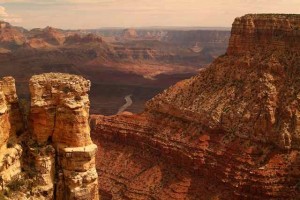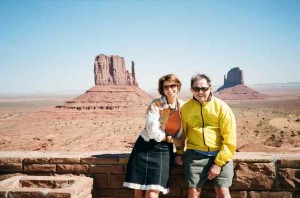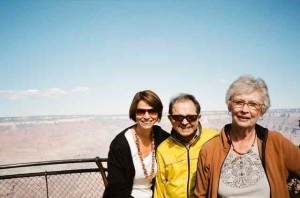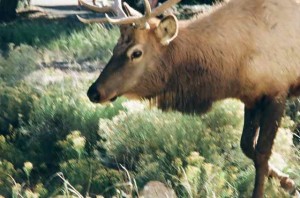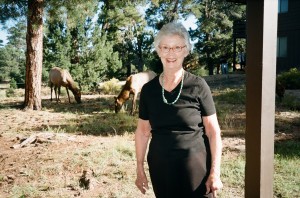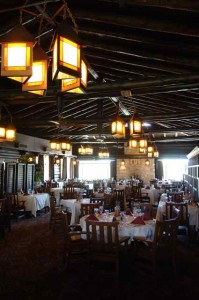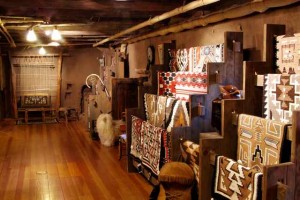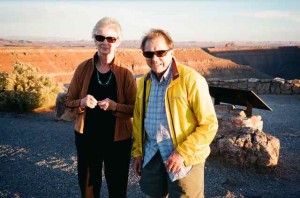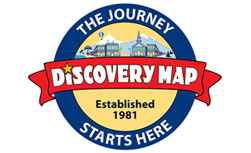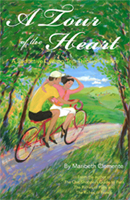Art & Culture Colorado Hotels & Lodging Shopping Telluride The Rockies The Southwest Travel: Art & Culture Colorado Hotels & Lodging Shopping Telluride The Rockies The Southwest Travel
by maribeth
2 comments
Touring the Southwest with My Parents
Are you familiar with those digital photo frames that display a continuous stream of select images? Well, I was back east in October visiting my parents and brought one of those frames to them as a gift. We had to enlist outside help (thanks Brian) to transfer my images onto the frame (I’m so eighteenth century), but once it started to flash our faces across the screen, we all beamed. My father especially glowed since he was finally able to see himself backdropped by a parade of images from the Grand Canyon and other notable sites in the Southwest. It was like bringing him back to the South Rim of the Canyon to gaze over the vastness and grandeur of what is most certainly our country’s greatest treasure.
We embarked on our two-week Western Jamboree just about a year ago. Fall and even winter are two fantastic seasons for visiting many of our National Parks, especially the Grand Canyon. During these times the wondrous play of light combined with a lack of crowds make these sites even more enchanting. The focal point of our trip was to be the Grand Canyon, a place my father always dreamed of seeing. At the age of eighty-four, we were ready to grant him his wish.
It had taken me weeks to plan this trip since I knew that doing a road trip with seniors represented certain important considerations. My brother, David, insisted we rent a big honking SUV, something I couldn’t fathom wielding around parking lots and other tight spaces. Fortunately he was right since we appreciated the comfort and roominess it provided more than we could have imagined. We felt solid powering across the wide-open spaces of some of America’s most stunning and desolate roadways.
I had planned the trip so that we’d do an average of four hours of driving on our travel days and spend at least two nights at most of the main stops on the itinerary. This worked out beautifully since we found ourselves leaving hotels late morning, breaking up the trip with lunch and arriving at our destination toward the end of the day—just at that perfect time when the sun bathed the scenery in a golden hue. This Hollywood-lighting effect rendered the views—especially the red rocks—all the more spectacular.
We set out from Telluride and moved from an alpine landscape to more buff-colored panoramas and within an hour and a half reached Cortez, Colorado. Here we passed the first of many trading posts we’d see throughout our travels. We crossed the Ute Indian Reservation as the colors changed from beige to pink and eventually to red toward Monument Valley. The rock formations became increasingly dramatic until we arrived at the most awe-inspiring of them all, the monuments of Monument Valley. I can honestly say that my dad’s jaw dropped and his eyes widened as he took in their magnificence.
Our stay at Goulding’s Lodge, the most historic place of lodging in Monument Valley, was punctuated by the history of western movie-making in this iconic land, an introduction to the Native American culture (something particularly new to dad) and chuck wagon-sized plates of food. Harry Goulding, a sheep trader, from Durango, Colorado, established the first trading post here in 1923 and began trading with the Native Americans. After the start of the Great Depression, Harry approached John Ford in Hollywood—having learned he wanted to make a western—and showed him pictures of Monument Valley. “Stagecoach,” directed by John Ford and starring John Wayne, was the first movie filmed in Monument Valley, a setting that’s still prominently featured today in all sorts of movies and commercials. We enjoyed Goulding’s old trading post museum and film, both of which recount the rich history of movie-making in the Valley.
From Monument Valley to Kayenta and then eventually to the Grand Canyon, the scenery morphed from flat to deep divides and hills, seemingly in preparation for what some might call the greatest gash on earth. Juniper, sage brush and pignon dotted the far-reaching vistas before us. We stopped for another huge plate of food at a Diné restaurant in Tuba City. (Mom and I had not yet had our share of Navajo fry bread and dad was enjoying the beans!) I learned that the very strange name of Tuba supposedly comes from Tuuvi, the name of a Hopi Indian Chief. We contemplated stopping to look at Dinosaur Tracks just outside of Tuba City but were afraid they might disappoint. (With seniors you have to pick and choose your stops—outside of bathroom breaks—very carefully.)
At the end of the third day, we arrived at the Grand Canyon in Arizona and caught our first glimpse of this Natural Wonder of the World at Desert View Watchtower. It truly felt like a resurrection of sorts, especially for dad. This would be the first (and actually one of the best) vantage points we’d visit within the next couple of days. Words cannot accurately describe the breathtaking views offered at every landing place along and within the Grand Canyon National Park.
If you haven’t been there—go! It seems as though foreigners have a better appreciation for one of our country’s greatest assets than most Americans. I hadn’t encountered so many visitors of so many different nationalities since I visited the Great Wall of China. Don’t miss what’s in your own backyard.
I visited the Canyon briefly when I was a teen and was astounded then. But this time, I became more in touch with the countless activities you can do there from visiting historical sites to hiking to shopping and more. In the company of two seniors, I dialed it down a lot, so the focus was mainly on sightseeing (and what sites there were to behold!), shopping and yes, more eating. It was just great to be at the Grand Canyon. Here huge elk herds slowed the cars, a mama doe and four babies brushed by us on our way to dinner and the smell of pine seemed to cling to the air most everywhere.
On the South Rim, the hub of most Grand Canyon activity including Grand Canyon Village, we enjoyed the use of a great shuttle bus service that ushered us to our various destinations. Friendly drivers pointed us in the right direction when I failed to see clearly through the abundance of maps and brochures I’d accumulated along the way. Dad, mom and I viewed the canyon from numerous points, outlooks and vistas, making sure that the walking distances were minimal for each site.
We restored ourselves over terrific meals and quickly deemed El Tovar, the most renowned lodge and restaurant of the many Grand Canyon establishments, our favorite. The contrast of the dark wood paneling of their cozy interior with the brightness of the Canyon views outside appealed to us greatly. But maybe we were most lured in by their delicious food, copiously served on pearl-white china, the exact replica of what was used on the Santa Fe railroad. We were also thrilled that here we were allowed to order half portions (at least for breakfast), a growing necessity at this juncture of the trip.
Mom and I reveled in the history and tradition of the El Tovar and many of the other sites at the Canyon. We dined here one night by ourselves, having left dad back at Maswick Lodge with a sandwich and his Fox TV, an addiction of sorts that he was surely becoming itchy about by now. We enjoyed an elegant dinner and then made a beeline for the El Tovar boutique. After a visit earlier that afternoon at the Hopi House across the way, we ascertained that the Grand Canyon offers some of the best shopping in the world.
The Fred Harvey Trading Company had been established here back in the day and their tradition of selling superior quality Native American Arts and Crafts continues today. We knew that at El Tovar we’d find jewelry of the highest quality, all at a fair price. Mom purchased a stunning string of Navajo silver beads for herself and offered me an apple-green gaspeite necklace that I’ve come to cherish along with the memories of the trip. With eight Native American tribes that still call the Grand Canyon home, the Canyon is well served in Native American arts and cultural influences of every kind.
On our way out of the Canyon, we stopped to watch the Imax Grand Canyon film at the National Geographic Visitor Center, twenty minutes outside of the Park. This sensational film offered yet a whole other set of perspectives of the Canyon from the adventures of Major John Wesley Powell, the first known person to explore the Colorado River to to modern-day rafting. It was terrific to see the Canyon and the mighty Colorado river from below since we had only viewed it from above. (Actually you can only see a sliver of the Colorado at certain vantage points along the rims.) Once again, I had the pleasure of seeing my dad bug-eyed at the wonders of this film. (My mom tends to be more reserved although I knew she loved it, too.)
We drove away fully satiated. The Grand Canyon did not disappoint.
“What a ribbon of road,” my mom exclaimed as she cruised along one of the seemingly never-ending stretches as we headed back in the direction of Kayenta and Monument Valley toward Bluff, Utah. It was the end of the day and the colors were changing from taupe to magenta to vermillion. We thought we had had enough of exclaiming over the scenery but at this point of the journey, we were mesmerized by the marbleized rust and cream tones of the earth.
A quick stop at Goosenecks, a spectacular geological site, featured in the film “Thelma and Louise,” starring Susan Sarandon and Geena Davis broke up the drive. Just enough for a few more oohs and aahs and another photo opp. We arrived in Bluff, Utah, a remote southwestern Utah town settled by Mormons in the 1880s, as the sun was sinking behind the red rocks and the sky muted into pink apricot. With its stunning red rock formations, millions of years of geological history and canyons that beg to be explored, it’s no wonder retired geologists and outdoor enthusiasts populate this isolated outpost today. We had a disappointing stay at the Calf Canyon B & B but our dinner at Cottonwood Steakhouse scored huge points on ambiance and authenticity. We reveled over their char-broiled steaks, cowboy beans, roasted potatoes and an unbelievably tasty apple pie. Our food fest throughout the Southwest had finally concluded. It was time to go home.
Our drive back to Telluride presented more transcending landscapes dominated, by red and beige and then copper and gold to dark green as we approached higher elevations. We marveled at the fall colors flanking the La Sal mountains outside of Blanding. I gazed wistfully out at the scenery of the Great American West, wondering if anything like this would ever be repeated with my parents again. Probably not. It was a once-in-a-lifetime trip, for all of us.
Thankfully we have many of the images from that trip on display on our digital photo frame, ever-lasting memories that will remain forever grand in our minds.
“The meaning of life is to make life meaningful,” as A.C. Grayling, a contemporary thinker and philosopher, stated in today’s New York Times.
For more about traveling with seniors, read Traveling with Seniors: A Lesson in Patience and Humility.
Note that we rented our vehicle from Alamo at the Montrose, Colorado airport and enjoyed excellent service.
